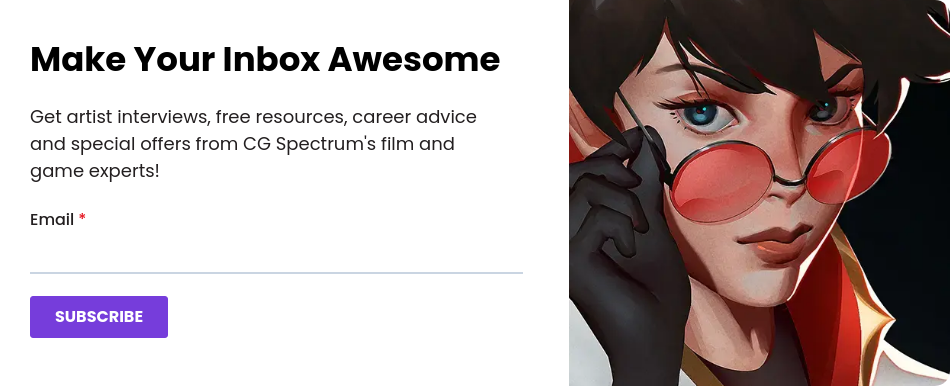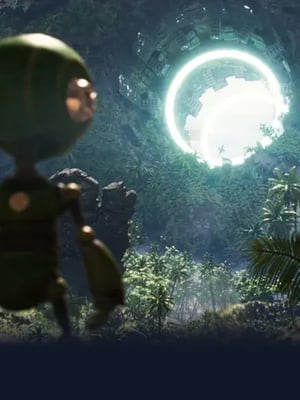In the competitive world of animation for film and games, it can be hard to stand out in the crowd. The best way to make a good first impression is through your portfolio. Those with an outstanding animation portfolio have a higher chance of catapulting into the best jobs in the industry.
Here’s what you need to know about designing your animation portfolio to help make a lasting impression.
What is an animation portfolio?
An animation portfolio (or demo reel) is a compilation of your best and most relevant animation work to show potential employers.
Your animation portfolio will contain short clips of your work to demonstrate your skills and style. It may be a combination of still images and moving animation, showing only the work you’re most proud of.
Why you need an awesome animation portfolio
Your animation portfolio will have the most influence over whether or not you get the job, even more so than your resume. Most employers are less interested in the specifics of your work history and more interested in seeing your animation skills in action. A portfolio helps studios to ascertain your skill level, animation style(s), range, and past experience/animation roles.
If your animation portfolio is entertaining and unique to you and your style, even without prior professional experience, it will help you stand out in the sea of other applicants. And if you're new to the craft, it could be your ticket to getting your first job in film and games.
Features of a stand-out demo reel
In our experience, the best demo reels:
- Are no more than 2-3 minutes long (1-2 minutes is ideal)
- Include a title card at the beginning and end (with your contact information)
- Show only your best work
- Show your best-of-the-best work first (to grab their attention)
- If you use music, ensure it doesn’t distract from your work
- Use original animation voice-over and audio if possible
- Present each piece individually, not in a collage style
- Provide context for each piece of work to highlight your involvement, and include credits where applicable
8 tips for creating a unique animation portfolio
Here are our top eight tips for making a unique animation portfolio that will get you noticed by employers:
1. Introduce yourself
Be sure to introduce yourself so studios can put a name to the work—you want them to be able to easily refer back to you if you left a good impression.
It’s also important to include contact details like a website or email address so that anyone who comes across your portfolio online knows how to contact you.
2. Include your best work
Your animation portfolio isn’t a showcase of everything you’ve ever drawn and animated. It should exhibit only your best work. It’s okay to include personal or school projects, especially if you are applying for your first job in film and games, as long as they are relevant and polished (work in progress is okay to include too as long as it's your best work).
If you’re showcasing a clip with collaborators, be sure to include a note explaining what part of the project you were responsible for.

3. Present your characters
Employers want to see that you can breathe life into an object or character on the screen. They want to see how you do this through character movement, mechanics, and nuance. Include examples where your character emotes in a way that is unique to them, even if it’s subtle (not all characters are super expressive).
4. Choose quality over quantity
Focus on quality work, not stuffing as much as you can in the portfolio. When choosing your best work for a general animation portfolio, showcase a range of your favorite or most honed skill sets. For a portfolio aimed at a specific job or studio, tailor the clips to the skills and styles they’re asking for in the job description.
If you can’t decide which clips show your best quality work, make a shortlist and show it to a colleague or mentor who can give you an expert and/or non-biased opinion.
Awesome demo reel examples
Here are three awesome demo reel examples and what we like about them:
This reel by Sykosan, Animation Director and Mentor of CG Spectrum's 2D animation courses, shows how you can play with editing to keep things interesting, splicing short clips from different projects (a mix of personal and client work) and returning to each one periodically throughout. Each clip is short but filled with Sykosan's best work—where he captures detailed action or poignant moments through his animation. For a 60-second reel, it packs a punch!
CG Spectrum Mentor of the 3D animation courses, Jon Vener's video game animation showreel is another great example. It's longer than the other two demo reels but is still well within the suggested time frame (and all the work is top quality). For each new clip, Jon has a detailed title card that includes the video game project and what type of animation he did on each character. It also integrates dialogue audio well in relevant scenes.
5. Focus on what makes you unique
There are many ways to create an animation reel portfolio. You can choose to follow a cookie-cutter template you find online, but employers will likely notice, and it won’t help you be memorable.
Think about what makes your style unique and use your skills to create a portfolio that represents those unique parts. This might be taking a typical animation challenge and giving it your signature twist or including recordings of your own motion capture scenes to demonstrate how a clip was made.
6. Keep it short
Recruiters receive stacks of applications to review. You’ll be lucky if you get 30 seconds of their attention, so keep your portfolio as concise as possible. This is why it’s critical to put your best and most relevant work at the beginning.
CG Spectrum's Department Head of 3D Animation Mark Pullyblank (Avatar, The Adventures of Tintin, The Smurfs, Night at the Museum), who started an animation career later in life, has this to say about what animation supervisors look for in animation portfolio reels:
“The only time I watch an entire reel is if it’s really, really good, or really, really bad.” -Mark Pullblank
We recommend keeping your portfolio under a minute if you don’t have any studio experience and under two minutes if you have a few years of professional animation experience.
7. Match your portfolio to the role
We encourage you to have several versions of your animation portfolio. Create one generic one that can be used anywhere, then customize your portfolio for more specific roles you apply for to demonstrate your niche styles and/or industry experience.
For example, if applying for a role as a 3D animator for a video game company, showcase more video game clips rather than examples from a 2D anime series you worked on.
8. Host your portfolio online
Whatever format you present your animation portfolio in (as a demo reel video or still images or a combination of both), find a reliable online platform to host your content. This makes it easy to share with employers and has the potential for people to find you on Google.
You don't need to create a specialized website, you can use any platform that lets you add content that others can view, such as Instagram, ArtStation, and Vimeo. If you do have a website, we recommend uploading any portfolio videos to YouTube or Vimeo and then embedding them on your website.
Keep in mind that your online portfolio will often be reviewed without you there to explain what's going on. Be sure to add text that provides additional context—what film your animation is from, what software you used, what aspects of the clip you were responsible for, etc.
Animation portfolio student showcase
At CG Spectrum, we’ve worked with thousands of students to help them create their animation portfolios to pursue a career in animation. Here are a few standouts from last year's students:
CG Spectrum's 2021 student showcase
Want to read more about our graduate’s successes? Read James Boyle’s story about how studying animation at CG Spectrum, and building an impressive animation portfolio, helped him switch careers to animation and land himself a job in the industry.
CG Spectrum's career services will help you create a unique animation portfolio
The best way to help guarantee your portfolio is high-quality and unique is to get support from professionals while creating it.
At CG Spectrum, study 2D or 3D animation via an industry-approved curriculum from an animation expert, and work on projects that will help you create exceptional work for your animation portfolio. Your mentors are also available to offer valuable feedback and guidance as you begin to compile work for potential employers.
CG Spectrum also offers personalized career services—including portfolio reviews, resume assistance, a jobs board, interview preparation, and more—led by our Career Development Manager.
Study animation at a training center that guides students in creating a unique animation portfolio to help ensure you make a lasting first impression!
Related Links




